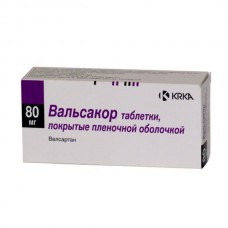Expiration date: 07/2025
Description pharmaceutical form:
Tablets 80 mg: round, biconvex tablets scored on one side, film coated pink.
Pills 160 mg: oval, biconvex tablets scored on one side, film-coated brownish-yellow color.
Pharmacokinetics:
Valsartan is rapidly absorbed after ingestion, however, the degree of absorption varies widely. Average absolute bioavailability of valsartan is 23%. The time required to achieve Cmax (Tmax) is 2 hours After the regular admission maximum decline AD comes through 4 weeks. While taking the drug once a day accumulation it slightly.
Plasma concentrations of valsartan are the same for men and women.
Valsartan actively associated serum protein (94-97%), mainly serum albumin. The equilibrium volume of distribution of the drug is small, about 17 l. Plasma clearance is relatively low (approximately 2 l/h) when compared with hepatic blood flow (about 30 l/h). Metabolized by the CYP2C9 enzyme system. T1/2 is 9 h. the Amount of valsartan, or excreted through the intestine is 70% absorbed after oral doses.
A urine output of 30%, mainly in unchanged form.
When taking valsartan with food decreases the area under the curve "concentration-time" (AUC) by 48%. However, after 8 h after ingestion the plasma concentrations of valsartan, taken on an empty stomach and with food, the same. The reduction in AUC is not accompanied by a clinically significant reduction in therapeutic effect of valsartan, therefore, the drug can be used both before and after a meal.
Special groups of patients
Patients with impaired renal function.Given that renal clearance accounts for only 30% of the value of total clearance in patients with impaired renal function is not required correction doses of the drug. Since the degree of binding of valsartan with plasma protein is high, its removal with hemodialysis is unlikely.
Patients with impaired liver function. About 70% of the absorbed valsartan dose is excreted in the bile, mainly unchanged. Valsartan is not exposed to significant biotransformation, therefore, its systemic effect is not correlated with the degree of liver dysfunction. Because of this, patients with liver failure nobiliario of origin and in the absence of cholestasis is not required to change doses of valsartan. In patients with biliary cirrhosis or biliary obstruction AUC of valsartan is increased about 2 times.
Description pharmacological action:
Valsartan is a selective antagonist of the angiotensin II receptor (type AT1) for intake of non-protein nature.
It has a selective antagonistic action on the receptor subtype AT1 Consequence of the blockade AT1-receptors is increased plasma concentration of angiotensin II, which can stimulate unlocked AT2-receptor subtype, which presumably modulates the effects of AT1-receptors. Valsartan has no agonist activity against AT1-receptors. His affinity for the receptor subtype AT1, approximately 20,000 times more, than for the AT2 receptor subtype.
Valsartan is not ingibiruet agents, also known as kininase II, which converts angiotensin I to angiotensin II and destroys bradykinin. In the absence of influence on APF not potenziruetsa effects of bradykinin and substance P, therefore, when the reception of antagonists of angiotensin II is unlikely the development of a dry cough. Valsartan does not enter into interaction and does not block other hormone receptors or ion channels involved in the regulation of the functions of the cardiovascular system.
In the treatment of hypertension valsartan lowers blood pressure without affecting heart rate.
After ingestion of a single dose of the drug the antihypertensive effect occurs within 2 h, while the maximum decrease in blood pressure is achieved within 4-6 h. the Antihypertensive effect of the drug lasts for 24 hours after his admission. When re-appointments valsartan maximum decrease in blood pressure, regardless of dose, achieved within 2-4 weeks and maintained at that level during long-term therapy. Combination with hydrochlorothiazide allows to achieve significant additional blood pressure reduction.
The sudden discontinuation valsartan is not accompanied by a sharp rise in blood pressure or other undesirable clinical consequences.
Tolerance to physical load
When evaluating the effects of valsartan (prescribed in addition to standard therapy for heart failure) on exercise capacity in patients with chronic heart failure II–IV functional class NYHA classification and the ejection fraction of the left ventricle (FULI) <40% p="">
No withdrawal syndrome upon sudden cessation of therapy.
Use after acute myocardial infarction
The use of valsartan in patients after 12 h to 10 days after myocardial infarction allows to reduce cardiovascular mortality and the development of recurrent myocardial infarction.
Indications:
- hypertension
- chronic heart failure (II–IV functional class NYHA classification) in the combined therapy (standard therapy) and in patients not receiving ACE inhibitors.
- the decline in cardiovascular mortality in stable patients who have developed failure/left ventricular dysfunction due to myocardial infarction.
Contraindications:
Hypersensitivity to valsartan or to other components of the drug, pregnancy and lactation, age to 18 years (the efficacy and safety of valsartan in children has not been proven), lactose intolerance, galactosemia or malabsorption syndrome glucose/galactose.
With caution: arterial hypotension, hepatic failure on the background of the bile duct obstruction, renal failure (Cl creatinine <10 p="">
Application of pregnancy and breast-feeding:
Data on the use of valsartan during pregnancy is not. Renal perfusion the fetus, which depends on the development of the renin-angiotensin system, begins to function in the third trimester of pregnancy. Risk to the fetus increases when taking valsartan in the second and third trimesters. During the pregnancy the therapy with valsartan should be immediately discontinued. No data on the allocation of valsartan in mother's milk. Therefore, to solve the issue of termination of breastfeeding or cancellation of therapy with valsartan, given its importance to the mother.
Side effects:
CNS and peripheral nervous system: often — headache, dizziness, including postural, vertigo, rarely — insomnia sometimes — faint (when used after myocardial infarction).
The respiratory system of the chest and mediastinum: often — cough, infections of the upper respiratory tract, pharyngitis, rhinitis, sinusitis.
Of the cardiovascular system: often- expressed lower AD and orthostatic hypotension sometimes (when used after myocardial infarction) — heart failure.
From the digestive tract: often — nausea, diarrhea, abdominal pain.
The skin and subcutaneous tissue: rare — skin rash.
From the muscles, skeleton and connective tissue often back pain, myalgia, arthralgia.
From the urogenital system: infrequently — decreased libido, very rarely — violation of the kidney.
Allergic reactions: very rarely — angioneurotic edema, skin rash, pruritus, hypersensitivity reactions, including serum sickness and vasculitis.
From the laboratory parameters: rare — reduction of concentration of hemoglobin and hematocrit, neutropenia, thrombocytopenia, hypercreatininemia, hyperbilirubinemia, increased liver transaminases, increased serum urea nitrogen often hyperkalemia.
Other: often — General weakness infrequent — edema, asthenia, fatigue.
Drug interactions:
Clinically significant pharmacokinetic interactions with other drugs is not observed. The drugs tested in clinical trials include cimetidine, warfarin, digoxin, atenolol, indomethacin, hydrochlorothiazide, amlodipine and glibenclamide.
As valsartan is not exposed to significant metabolism, you should not expect and significant drug interactions associated with induction or inhibition of cytochrome P450. The simultaneous appointment kalisberegath dioretikov (spironolactone, triamterene, amiloride), potassium supplements can cause hyperkalemia, therefore requires caution. When co-administered with diuretics may increase the hypotensive effect.
Method of application and dose:
Inside, regardless of meals, the multiplicity of reception — 1-2 times a day.
Hypertension. The recommended dose is 80 mg 1 time per day, regardless of age, sex or race of the patient. Antigipertenzivny effect develops over 2 weeks and reaches its maximum after 4 weeks. The maximum daily dose — 320 mg/day. Patients with impaired renal function and liver debelyanovo origin and without cholestasis does not require changes in doses. It is possible to combine with other antihypertensive drugs.
Chronic heart failure. The recommended starting dose is 40 mg 2 times a day. Perhaps a gradual increase to 80 mg, with good endurance — up to 160 mg 2 times per day, i.e. up to the maximum dose tolerated by the patient. The maximum daily dose — 320 mg, divided into 2 doses. In patients simultaneously receiving diuretics, and in patients with heart failure requires constant monitoring of kidney function, blood pressure. With the appearance of clinical signs of hypotension should reduce the dose.
Use after acute myocardial infarction. In clinically stable patients, treatment should be started within 12 h after myocardial infarction. After the assignment of an initial dose of 20 mg 2 times a day (1/2 tab. 40 mg with valium), drug dose Valsaceae increased to 40, 80 and 160 mg 2 times a day for several weeks. The maximum daily dose is 160 mg 2 times per day. 2 weeks after starting treatment with the drug Valsacor need to achieve a dose of 80 mg 2 times a day and the dose of 160 mg 2 times per day can be achieved after 3 months of drug therapy Valsacor. The target dose depends on the tolerability valsartan during the period of titration of doses.
With the development of symptomatic arterial hypotension or renal failure should reduce the dose of the drug.
Assessment of patients after myocardial infarction should include monitoring of renal function.
Patients with impaired liver function debelyanovo origin without signs of cholestasis dose adjustment is not required.
Overdose:
Symptoms: in Spite of the lack of sufficient data, the expected main manifestation of an overdose of the drug is marked reduction in blood pressure, which can lead to collapse and/or shock.
Treatment: symptomatic, it is recommended to induce vomiting and stomach wash. With the development of arterial hypotension/injected 0.9% sodium chloride solution. Hemodialysis is ineffective.
Special instructions:
Heart failure. Use in patients with heart failure is usually accompanied by a decrease in blood pressure, however, subject to the recommendations on the selection of doses of treatment rarely requires discontinuation due to hypotension. Therapy Vilcacora in patients with heart failure should begin with caution. Due to the suppression of renin-angiotensin-aldosterone system activity in some patients may change renal function. In severe heart failure may develop oliguria and/or progressive azotemia, up to (rarely) acute renal failure and/or death. In patients with heart failure requires constant monitoring of renal function with concomitant administration of combination of 3 classes of drugs — ACE inhibitors, beta-blockers and antagonists of the angiotensin II receptor AT1.
Perhaps the appointment in conjunction with other drugs prescribed after myocardial infarction: with thrombolytic drugs, acetylsalicylic acid, beta-blockers and statins.
Patients with deficiency of sodium and/or fluid. In patients with severe deficiency of sodium and /or reduced BCC (for example as a result of receiving high doses of diuretics) in rare cases at the beginning of therapy with valsartan may develop severe hypotension. Before starting treatment with Vilcacora recommended to restore the contents of electrolytes and fluid in the body, in particular by reducing the doses of diuretics.
With the development of arterial hypotension with clinical manifestations: the patient should be laid on his back and, if necessary, the solution is administered 0.9% solution of sodium chloride. Therapy Vilcacora can continue only after stabilization of blood pressure parameters.
Renal artery stenosis. In patients with bilateral or unilateral renal artery stenosis is necessary to constantly monitor the content of creatinine and urea nitrogen in serum.
The impairment of renal function. In patients with renal impairment is not required to change doses of the drug.
Due to the lack of data on the use of drugs in severe renal failure (Cl creatinine <10 0="" 167="" p="">
The liver dysfunction. In patients with impaired liver does not require changes in doses.
Valsacor bile appears mainly. In patients with obstructive diseases of the biliary tract was observed a decrease in the clearance of Valsacor, therefore, in such cases the drug should be administered with caution.
Special information on the auxiliary substances. Valsacor contains lactose, so the drug is contraindicated in patients with lactase deficiency, galactosemia or malabsorption syndrome of glucose-galactose.
Effects on ability to drive and other mechanisms. Patients should observe caution while driving and other mechanisms that require attention.


